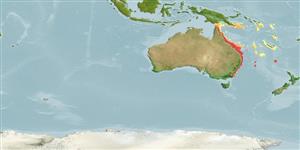Environment: milieu / climate zone / ລະດັບຄວາມເລິກ / distribution range
ນິເວດວິທະຍາ
ສັດທະເລ; ນ້ຳກ່ອຍ ອາໄສຢູ່ໃກ້ໜ້າດິນໃຕ້ພື້ນທ້ອງນ້ຳ; ບໍ່ມີການເຄື່ອນຍ້າຍ; ລະດັບຄວາມເລິກ 0 - 46 m (Ref. 6335), usually 20 - 22 m. Tropical; 9°S - 45°S, 142°E - 170°E (Ref. 6205)
Western Pacific: east coast of Australia from Cape York (rare) and the Great Barrier Reef, Queensland to eastern Victoria, Ulverstone on northeast coast of Tasmania; Lord Howe Island, New Caledonia, Woodlark Islands, and Papua New Guinea. Bleeker's records (Ref. 1502, 1843) from Batavia and Java were in error (Ref. 4899).
Length at first maturity / ຂະໜາດ / ນ້ຳໜັກ / Age
ການຈະເລີນເຕັມໄວ: Lm 24.0 range ? - ? cm
Max length : 51.0 cm TL ຕົວຜູ້/ບໍ່ມີເພດ; (Ref. 6205); ນ້ຳໜັກສູງສຸດທີ່ເຄຍຈັດພີມມາ: 1.4 kg (Ref. 6390); ອາຍຸສູງສຸດທີ່ເຄຍລາຍງານມາ: 22 ປີ (Ref. 1254)
ຄີ (ໜາມ)ແຂງຢູ່ຫຼັງປາ (ທັງໝົດ) : 12; ຄີຫຼັງຂອງປາ (ຄີອ່ອນ) (ທັງໝົດ) : 16 - 18; ຄີ(ໜາມ) ແຂງຢູ່ຄີກົ້ນປາ
ກຸ່ມປາກະດູກແຂງ
ຄວາມຖີ່ຂອງກຸ່ມຖ່າຍທອດພັນ
ປາທີ່ມີການເຄື່ອນຍ້າຍຈາກທະເລໄປຫານ້ຳຈືດ ແລະນ້ຳຈືດຫາທະເລ
ປາທີ່ມີການເຄື່ອນຍ້າຍຈາກທະເລແລະໄປໄຂ່ຢູ່ນ້ຳຈືດ
ຄີກົ້ນຂອງປາ
ສັດທີ່ມີກະດູກສັນຫັຼງ
ການຖ່າຍທອດທາງກຳມະພັນຈາກພໍ່ແມ່ຫາລູກ: 2; ຄີກົ້ນຂອງປາ: 15 - 17; ສັດທີ່ມີກະດູກສັນຫຼັງ: 32 - 34. The shape of the swim bladder is not distinguishable from that of S. analis. Anterior part of the swim bladder with rudimentary tubules projecting anteriorly and a series laterally that diminish in size and become sawtooth-like posteriorly. The coloration of adult specimens is uniform, without darker bars or blotches. A dark spot is present at the base of the pectoral fin in younger individuals.
Body shape (shape guide): fusiform / normal; Cross section: circular.
An onshore schooling species occurring on coastal beaches, sandbars, and surf zones as well as open bays, estuaries, coastal lakes (Ref. 6205), and rivers as far as tidal limits (Ref. 6390). Keep away from shore when older. Live almost exclusively on sandy ground. Juveniles and adolescents are abundant in shallow waters of rivers and creeks, over seagrass beds and in mangroves (Ref. 6223), although they tend to move into deeper water as they grow older (Ref. 6390). Larvae are present in river mouths and mangrove areas most of the year (Ref. 27634). Oviparous (Ref. 205). Feed mostly on polychaetes and crustaceans. Also caught using tunnel nets (Ref. 6205).
Sand whiting probably spawn twice each season (Ref. 1254, 27633). Spawning occurs at peak high tide, at night, and 1-2 days before the new moon (Ref. 6390).
McKay, R.J., 1992. FAO Species Catalogue. Vol. 14. Sillaginid fishes of the world (family Sillaginidae). An annotated and illustrated catalogue of the sillago, smelt or Indo-Pacific whiting species known to date. Rome: FAO. FAO Fish. Synop. 125(14):87p. (Ref. 6205)
IUCN Red List Status (Ref. 130435: Version 2025-1)
Threat to humans
Harmless
Human uses
ການປະມົງ: ທີ່ມີການຄ້າສູງ; ການລ້ຽງສັດນ້ຳ: ການທົດລອງ; ຊະນິດປາທີ່ຖືກນຳໃຊ້ເຂົ້າໃນການຫາເພື່ອເປັນເກມກິລາ: ແມ່ນ; ຕູ້ປາ: ບ່ອນວາງສະແດງສັນນ້ຳຂອງລັດ
ເຄື່ອງມື
Special reports
Download XML
ແຫຼ່ງອີນເຕີເນັດ
Estimates based on models
Preferred temperature (ເອກະສານອ້າງອີງ
123201): 21.2 - 27.4, mean 25.4 °C (based on 182 cells).
Phylogenetic diversity index (ເອກະສານອ້າງອີງ
82804): PD
50 = 0.5000 [Uniqueness, from 0.5 = low to 2.0 = high].
Bayesian length-weight: a=0.00617 (0.00341 - 0.01114), b=3.13 (2.96 - 3.30), in cm total length, based on LWR estimates for this species & (Sub)family-body (Ref.
93245).
ຊັ້ນເຂດຮ້ອນ (ເອກະສານອ້າງອີງ
69278): 3.2 ±0.2 se; based on diet studies.
ຄວາມຢືດຢຸ່ນ (ເອກະສານອ້າງອີງ
120179): ຂະໜາດກາງ, ປະຊາກອນຕຳ່ສຸດທີ່ໃຊ້ເວລາສອງເທົ່າ 1.4 - 4.4 ປີ (K=0.39; tm=2-3; tmax=22; Fec=31,000).
Fishing Vulnerability (Ref.
59153): Low to moderate vulnerability (28 of 100).
🛈
Nutrients (Ref.
124155): Calcium = 348 [82, 932] mg/100g; Iron = 1.22 [0.47, 3.13] mg/100g; Protein = 20.8 [18.0, 23.0] %; Omega3 = 0.221 [0.099, 0.482] g/100g; Selenium = 43.2 [14.8, 143.3] μg/100g; VitaminA = 27.7 [5.9, 122.3] μg/100g; Zinc = 1.25 [0.65, 3.06] mg/100g (wet weight);
